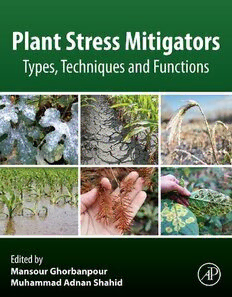
Plant Stress Mitigators: Types, Techniques and Functions PDF
Preview Plant Stress Mitigators: Types, Techniques and Functions
Plant Stress Mitigators Types, Techniques and Functions Thispageintentionallyleftblank Plant Stress Mitigators Types, Techniques and Functions Edited by Mansour Ghorbanpour Department of Medicinal Plants, Faculty of Agriculture and Natural Resources, Arak University, Arak, Iran Muhammad Adnan Shahid Horticultural Sciences Department, University of Florida/IFAS, North Florida Research and Education Center, Quincy, FL, United States AcademicPressisanimprintofElsevier 125LondonWall,LondonEC2Y5AS,UnitedKingdom 525BStreet,Suite1650,SanDiego,CA92101,UnitedStates 50HampshireStreet,5thFloor,Cambridge,MA02139,UnitedStates TheBoulevard,LangfordLane,Kidlington,OxfordOX51GB,UnitedKingdom Copyright©2023ElsevierInc.Allrightsreserved. Nopartofthispublicationmaybereproducedortransmittedinanyformorbyanymeans,electronicormechanical,including photocopying,recording,oranyinformationstorageandretrievalsystem,withoutpermissioninwritingfromthepublisher. Detailsonhowtoseekpermission,furtherinformationaboutthePublisher’spermissionspoliciesandourarrangementswith organizationssuchastheCopyrightClearanceCenterandtheCopyrightLicensingAgency,canbefoundatourwebsite:www. elsevier.com/permissions. ThisbookandtheindividualcontributionscontainedinitareprotectedundercopyrightbythePublisher(otherthanasmaybe notedherein). Notices Knowledgeandbestpracticeinthisfieldareconstantlychanging.Asnewresearchandexperiencebroadenourunderstanding, changesinresearchmethods,professionalpractices,ormedicaltreatmentmaybecomenecessary. Practitionersandresearchersmustalwaysrelyontheirownexperienceandknowledgeinevaluatingandusinganyinformation, methods,compounds,orexperimentsdescribedherein.Inusingsuchinformationormethodstheyshouldbemindfuloftheir ownsafetyandthesafetyofothers,includingpartiesforwhomtheyhaveaprofessionalresponsibility. Tothefullestextentofthelaw,neitherthePublishernortheauthors,contributors,oreditors,assumeanyliabilityforanyinjury and/ordamagetopersonsorpropertyasamatterofproductsliability,negligenceorotherwise,orfromanyuseoroperationof anymethods,products,instructions,orideascontainedinthematerialherein. ISBN:978-0-323-89871-3 ForInformationonallAcademicPresspublications visitourwebsiteathttps://www.elsevier.com/books-and-journals Publisher:NikkiP.Levy AcquisitionsEditor:NancyMaragioglio EditorialProjectManager:LindsayLawrence ProductionProjectManager:BharatwajVaratharajan CoverDesigner:VictoriaPearson TypesetbyMPSLimited,Chennai,India Dedication Dedicated to: Professor Majid Samii, a distinguished Iranian neurosurgeon and medical scientist. He has been the president of the International Society for Neurosurgery and named as the “top world neurosurgeon.” Thispageintentionallyleftblank Contents Listofcontributors xv 2.8 Indirectmechanisms 38 2.8.1 Antifungalmetabolites 38 1. Approaches in stress mitigation of 2.8.2 Biosurfactants(surface-active plants 1 compounds) 39 2.8.3 Siderophores 39 GyanaRanjanRout,KundanRajpalsinghJadhao, 2.8.4 Cellwalldegradingenzymes 40 SurabhikaPandaandRinnySwain 2.8.5 Inductionofsystemicresistance 41 2.9 Improvementofgrowthandbiocontrol 1.1 Introduction 1 ofsoilbornediseasesusingantagonist 1.2 Abioticstressmitigation 2 fungi 42 1.2.1 Droughtstressandmitigation 5 2.10 Summaryofmechanicsemployedby 1.2.2 Salinitystressandmitigation 8 antagonistfungiasgrowthpromoters 1.2.3 Temperaturestressandmitigation 9 andbiocontrolagents 43 1.2.4 Metalstressandmitigation 10 2.10.1 Competitionefficientlyforspace 43 1.2.5 Submergencestressandmitigation 11 2.10.2 Productionofmetabolites 44 1.2.6 Coldstressandmitigation 12 1.3 Bioticstressmitigation 14 2.10.3 Rootcolonization 44 2.11 Improvementofgrowthand 1.4 Conclusionsandfutureperspectives 16 References 17 biocontrolofsoilbornediseasesby meansofVAMfungi 45 2. Biocontrol: a novel eco-friendly 2.12 Summaryofmechanicsemployedby mitigation strategy to manage VAMfungiasgrowthpromotersand plant diseases 27 biocontrolagents 46 2.13 “Combination”thebestwayto MahtabOmidvari,PaymanAbbaszadeh-Dahaji, biocontroloftheplantdiseases 46 MehrnazHatamiandKhalilKariman 2.14 Conclusionsandfuturestrategiesto 2.1 Introduction 27 makebetteruseofbiocontrolagents 47 2.2 Mechanismsofbiologicalcontroland References 49 biologicalantagonists 29 2.3 Therhizosphereisahabitatfor microorganisms 29 3. Salicylic acid induced abiotic 2.4 Improvementofgrowthandbiocontrol stress tolerance in plants 57 ofsoilbornediseasesusingPGPRs 30 MuhammadFasihKhalid,MuhammadShahzad 2.5 Advantagesandlimitations 31 Saleem,IqraZakir,RashidIqbalKhan, 2.6 Summaryofmechanismsemployedby MuhammadSohail,ShaghefEjaz, PGPRasgrowthpromotersand MuhammadAkbarAnjum,SamreenSabir, biocontrolagents 31 SajidAli,ShakeelAhmadandSajjadHussain 2.7 Directmechanisms 32 2.7.1 Productionofplantgrowth 3.1 Introduction 57 regulators(phytohormones) 3.2 Salicylicacidandabioticstresses 58 byPGPR 32 3.3 Salicylicacidanddrought 58 2.7.2 Biologicalnitrogenfixation 35 3.4 Salicylicacidandwaterlogging 59 2.7.3 Phosphatesolubilization 36 3.5 Salicylicacidandheavymetals 59 2.7.4 Rootcolonizationandrhizosphere 3.6 Salicylicacidandlowtemperature 60 competence 36 3.7 Salicylicacidandhightemperature 61 vii viii Contents 3.8 Salicylicacidandsalinity 62 5. Germination and seedling 3.9 Conclusions 63 establishment of useful tropical References 63 trees for ecological restoration: implications for conservation: 4. Salicylic acid mediated postharvest The ecologyof tropical tree seedling 87 chilling and disease stress tolerance in horticultural crops 69 RizwanaKhanum 5.1 Introduction 87 SajidAli,MuhammadAkbarAnjum, 5.2 Externalfactors 88 SamiUllah,AamirNawaz,ShaghefEjazand 5.2.1 Light 88 GhulamKhaliq 5.2.2 Temperatureandmoisture 90 4.1 Introduction 69 5.2.3 Soiltypes/soilpreferences 91 4.2 Postharvestchillinginjury(CI)stressin 5.3 Internalfactors 91 freshhorticulturalcrops 70 5.3.1 Seedstructureandseedgermination 91 4.3 FactorsaffectingCIdevelopmentin 5.3.2 Seedmaturityanddormancy 92 horticulturalcrops 70 5.4 Implicationsforconservationof 4.3.1 Maturitystage 70 tropicaltrees 94 4.3.2 Genotypes 71 References 95 4.3.3 Storagetemperature 71 4.3.4 Storageduration 71 6. Soil health and plant stress 4.3.5 Storageconditions 71 mitigation 99 4.4 EffectsofCIonqualityofhorticultural crops 72 MisbahNaz,Rau´lCarlosLo´pez-Sa´nchez, 4.4.1 EffectofCIonbiochemical LauraOliviaFuentes-Lara, quality 72 MarcelinoCabrera-DelaFuenteand 4.4.2 EffectofCIonsensoryattributes 72 AdalbertoBenavides-Mendoza 4.4.3 EffectofCIonvisualquality 72 6.1 Theconceptofsoilhealth 99 4.4.4 EffectofCIonaromavolatiles 72 6.2 Theimpactofagricultureonsoil 4.5 PostharveststrategiesforCImitigation 73 health 102 4.6 EffectofsalicylicacidonCImitigation 6.3 Soilhealthandbiodiversity 104 inhorticulturalcrops 73 6.4 Soilhealth,biodiversity,andplant 4.7 MechanismofsalicylicacidinCI stress 107 mitigation 75 6.5 Conclusion 110 4.8 Salicylicacidandpostharvestdisease References 110 stresstoleranceofhorticulturalcrops 77 4.8.1 Diseasesinducedpostharvest 7. Salicylic acid and ascorbic acid as lossesofhorticulturalcrops 77 4.8.2 Salicylicacidanditspossible mitigators of chilling stress in mechanismfordiseasecontrol 77 plants 115 4.9 Postharvestdiseasescontrolwithsole MahmoudEl-BazYounis, salicylicacidtreatments 79 MohammedNagibAbdel-GhanyHasaneenand 4.9.1 Preharvestsolesalicylicacid HebaMahmoudMohammadAbdel-Aziz applications 79 4.9.2 Postharvestsolesalicylicacid 7.1 Introduction 115 treatments 79 7.2 Physiologicalandbiochemical 4.9.3 Combinedapplicationofsalicylic effectsofchillingstress 115 acidandotherchemicalsfor 7.3 Physiologicalandbiochemical diseasecontrol 79 effectsofadaptive(protective) 4.9.4 Combinedapplicationofsalicylic compounds 118 acidwithbiocontrolagentsfor 7.3.1 Salicylicacid 119 diseasecontrol 80 7.3.2 Ascorbicacid 120 4.10 Conclusionandfutureprospects 81 7.4 Conclusion 121 References 81 References 122 Contents ix 8. Role of glycine betaine in the 10.3 Proline 174 protection of plants against 10.3.1 Prolinebiosyntheticpathways 174 environmental stresses 127 10.3.2 Theprolinefunctionsin resistancetostress 174 Nikoleta-KleioDenaxa,AthanasiosTsafouros, 10.3.3 Reactiveoxygenspecies EfstathiosNtanosandPeterA.Roussos scavenging 177 10.4 Effectofsugarsonanaccumulation 8.1 Introduction 127 ofproline 177 8.2 Efficacyofglycinebetaineapplication 10.5 Prolineandabioticstress 178 againsttemperatureandhigh 10.5.1 Drought 178 irradiancestress 129 10.5.2 Salinity 178 8.3 Efficacyofglycinebetaineapplication 10.5.3 Heatandchillingstress 179 againstdroughtstress 135 10.5.4 Heavymetalstress 179 8.4 Efficacyofglycinebetaineapplication 10.6 Conclusions 179 againstsalinitystress 141 References 180 8.5 Efficacyofglycinebetaineapplication againstheavymetalstoxicitystress 145 11. Switching role of hydrogen sulfide 8.6 Efficacyofglycinebetaineapplication in amelioration of metal stress in againstwaterloggingandflooding 149 plant 187 References 149 RahulDilawari,SahilMehta, 9. Effects of plant growth regulators BaljinderSinghandVimalPandey on physiological and phytochemical 11.1 Introduction 187 parameters in medicinal plants 11.2 Hydrogensulfidekeyregulatory under stress conditions 159 moleculeduringstresseventsinplants 188 11.3 Hydrogensulfidesynthesis 189 HamidMohammadi,SaeidHazratiand 11.4 Hydrogensulfidewitheffectof MehrnazHatami priminginplantcells 189 9.1 Introduction 159 11.5 Hydrogensulfideincuringvarietyof 9.2 Plantgrowthregulatorseffectson metalstressandtoxicityindifferent plantperformance 159 plantspecieswithdifferentparts 191 9.3 Effectofplantgrowthregulatoron 11.6 Arsenic 194 medicinalplants 163 11.7 Aluminum 194 9.4 Conclusions 164 11.8 Boron 194 References 164 11.9 Cadmium 194 11.10 Chromium 195 10. Proline and soluble carbohydrates 11.11 Cobalt 195 biosynthesis and their roles in 11.12 Copper 195 plants under abiotic stresses 169 11.13 Lead 195 11.14 Nickel 195 SoheylaMohammadiAlagoz, 11.15 Zinc 196 BehnamAsgariLajayerand 11.16 Conclusions 196 MansourGhorbanpour References 196 10.1 Introduction 169 Furtherreading 199 10.2 Carbohydrates 170 12. PGPR reduces the adverse effects 10.2.1 Theroleofsoluble of abiotic stresses by modulating carbohydratesinplantsgrowth morphological and biochemical anddevelopment 170 10.2.2 Sucrosemetabolization 170 properties in plants 201 10.2.3 Accumulationofsolublesugars MahmoodMaleki,FoadFatehiand asastrategyforresistanceto MansourGhorbanpour abioticstresses 172 10.2.4 Correlationbetweenabiotic 12.1 Introduction 201 stressfactorsandsugarsinplants 173 12.2 Abioticstress 202
